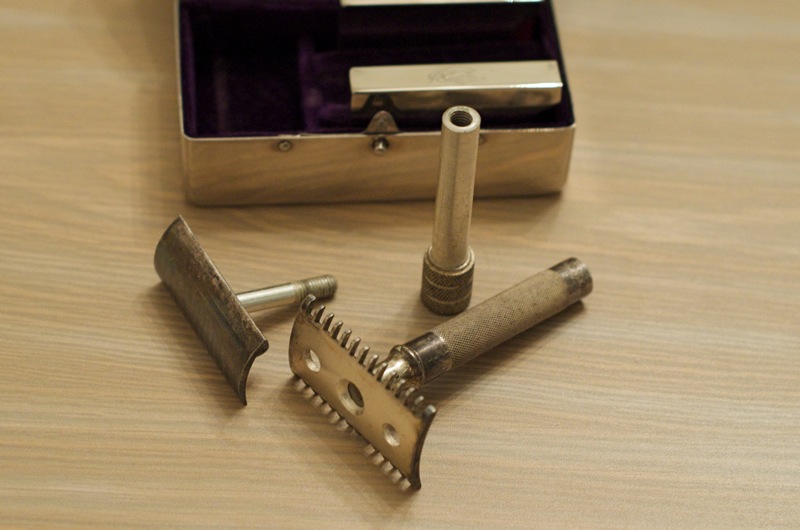This morning I ran across a 1916 article by Thomas W. Pelham in Advertising and Selling dated May 1916. I think it belongs in this thread. It is labeled as an "interview", but it reads more like an article. As most of us probably know, Pelham was a lawyer and an important person in the company, running both sales and marketing. In this article Pelham touches on the early history of safety razors, naturally to explain what sort of advertising and selling the Gillette razor required. Click through for the full view in google books.

Reading through it I spotted at least one typo: "after the formation of the company (in 1904)" should probably be "in 1901" when the company was first formed, or perhaps 1902 when it was renamed after Gillette. Of course Pelham himself first used a Gillette razor in 1903, according to McKibben - that is another story I would like to hear in more detail. Anyway there is no mention of the early ads in System in October-November 1903, nor anything about 1903 at all. Instead he begins with 1904 and 'automatic signs that that went through the motions of shaving even illustration the "angle stroke".' I think that would be the Gillette Slide, and I would love to see one of those signs in action.
Pelham mentions the 1907 decision to open a factory in England, but adds no details to what we already know. Significantly he talks about "branches in all the European countries" and global "reach", but only mentions a factory in England. Interestingly he does not mention closing the factory in England (Leicester), which we think happened in January 1916. Likely the article was written a few weeks before publication, but probably not months prior. More likely he did not think it was relevant to his story.
Pelham also says that advertising for all countries was coordinated in Boston. I wonder about that: usually local perspective is essential for effective advertising, and ads like http://mr-razor.com/Werbung/C 1912 Combination Set French.jpg look to me like local products. But perhaps Pelham simplified a more complex process.
Pelham reveals that "by far the greater volume of business" goes through jobbers: wholesale buyers who then distribute to retailers. But they also continued to sell directly to retailers and directly to consumers. Finally he mentions increased demand due to the war, 80% higher than 1915, and hints that demand is outstripping supply.
At the top of this article Pelham is described as "President". But I had thought King Camp Gillette was company president at the time, albeit mostly in an honorary role. Looking at the 1916 Poor's Manual of Industrials, vol. 7, p513 I see King Camp as President, Joyce as Vice-President, and no officer role for Pelham. But that would refer to 1915, and I cannot find a reference for 1916. Or it might be an error that crept into the article.
1916 was before the government contract, correct? Anyone know exactly when that began?
Also I see that 1916 was the year John J. Joyce retired as chairman, and John E. Aldred took over. I think Joyce died in January 1917, but does anyone know exactly when he retired? It may not matter much: Pelham and Fahey seemed to run the show.
Reading through it I spotted at least one typo: "after the formation of the company (in 1904)" should probably be "in 1901" when the company was first formed, or perhaps 1902 when it was renamed after Gillette. Of course Pelham himself first used a Gillette razor in 1903, according to McKibben - that is another story I would like to hear in more detail. Anyway there is no mention of the early ads in System in October-November 1903, nor anything about 1903 at all. Instead he begins with 1904 and 'automatic signs that that went through the motions of shaving even illustration the "angle stroke".' I think that would be the Gillette Slide, and I would love to see one of those signs in action.
Pelham mentions the 1907 decision to open a factory in England, but adds no details to what we already know. Significantly he talks about "branches in all the European countries" and global "reach", but only mentions a factory in England. Interestingly he does not mention closing the factory in England (Leicester), which we think happened in January 1916. Likely the article was written a few weeks before publication, but probably not months prior. More likely he did not think it was relevant to his story.
Pelham also says that advertising for all countries was coordinated in Boston. I wonder about that: usually local perspective is essential for effective advertising, and ads like http://mr-razor.com/Werbung/C 1912 Combination Set French.jpg look to me like local products. But perhaps Pelham simplified a more complex process.
Pelham reveals that "by far the greater volume of business" goes through jobbers: wholesale buyers who then distribute to retailers. But they also continued to sell directly to retailers and directly to consumers. Finally he mentions increased demand due to the war, 80% higher than 1915, and hints that demand is outstripping supply.
At the top of this article Pelham is described as "President". But I had thought King Camp Gillette was company president at the time, albeit mostly in an honorary role. Looking at the 1916 Poor's Manual of Industrials, vol. 7, p513 I see King Camp as President, Joyce as Vice-President, and no officer role for Pelham. But that would refer to 1915, and I cannot find a reference for 1916. Or it might be an error that crept into the article.
1916 was before the government contract, correct? Anyone know exactly when that began?
Also I see that 1916 was the year John J. Joyce retired as chairman, and John E. Aldred took over. I think Joyce died in January 1917, but does anyone know exactly when he retired? It may not matter much: Pelham and Fahey seemed to run the show.

